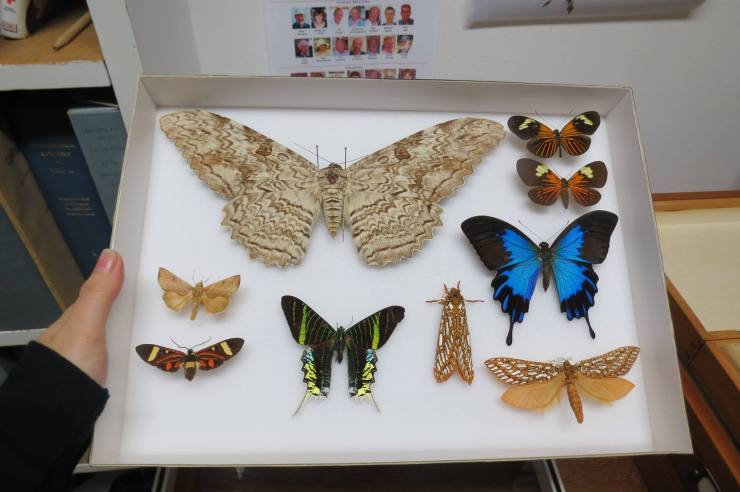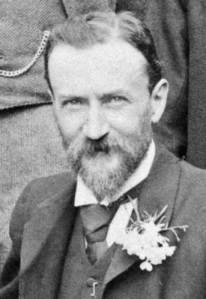
Our monthly staff meetings are a chance to catch up on what’s happening across the Museum. But recently it’s also been used as an opportunity to share some of the hidden gems in the Museum’s collection. Each month, one member of staff selects 5 of their personal favourite specimens to talk about. We thought that you might like to share this experience, so the Top 5 will be blogged here each month for you to enjoy.
With 2 million butterflies and moths in the Museum’s collection, choosing a top 5 is certainly a challenge. But Gina Allnatt is feeling brave…
**

I work on the Lepidoptera Project, which is a two-year project to database, catalogue, re-curate and photograph moths and butterflies in the Life collections. Because it’s such a large and amazing collection, I had trouble deciding what to choose for top five specimens. In fact, I almost wish it had been a top ten. But who knows…maybe there will be a part two to this at some point.
So here goes…
5 – Wallace’s Golden Birdwing (Ornithoptera croesus)

This is a recent discovery and one we’re very excited about. We believe that this is the specimen, or one of the specimens, that Alfred Russel Wallace described so passionately in correspondence to his dealer Samuel Stevens.
The beauty and brilliancy of this insect are indescribable, and none but a naturalist can understand the intense excitement I experienced when I at length captured it. On taking it out of my net and opening the glorious wings, my heart began to beat violently, the blood rushed to my head, and I felt much more like fainting than I have done when in apprehension of immediate death. I had a headache the rest of the day, so great was the excitement produced by what will appear to most people a very inadequate cause. –A.R. Wallace 1859, from Proceedings of the Entomological Society.
Observant Wallace fans may have noticed that it doesn’t have Wallace’s typical round labels. It was re-labelled when it was donated to the Museum in 1871. It seems that Hewitson, a wealthy collector, removed all the original labels when they came into his care – a nightmare for me when I’m trying to trace things!
4. Lampides carissima from the Challenger Expedition

One of our volunteers, Willow, was databasing a drawer of Lycaenidae and he asked me why there was one butterfly separate from the main group. He wanted to know what species it was so he could database it. So I picked up the specimen and I immediately saw “Challenger, July 1874”.

Entomologist Arthur Gardiner Butler, who then worked at the British Museum, produced a paper called “The Lepidoptera collected during the recent expedition of the H.M.S. Challenger,” which lists all the species of butterflies and moths collected on the expedition and where they were found. And there, in the paper, we have; “Jamides carissima, collected Tongatabu, July 1874″. This is the only Challenger specimen we have found so far in the Entomology collections, but there could well be more. We’ll see… 
3. Extinct Moths and Butterflies

The collection contains some extinct and critically endangered moths, all of which were endemic to particular islands around the world. Above you can see the Kona Giant Looper moth, which was endemic to Hawaii. Two females and one male collected by R.C.L Perkins. This was one of the world’s largest Geometrids. This shows how important historic collections are for reminding us what we have, what we’ve lost and what we need to look after.
2. Wallace’s Sun Moth

This specimen came from the Brazilian orchid house of Alfred Russel Wallace. It’s a moth from the family Castniidae, or Sun Moths. When the moth was first found it caused a bit of confusion; Wallace was thrown by the insect’s moth-like appearance and clubbed antennae. Was it a moth or a butterfly? This reminds us that there are exceptions to every rule – when someone tells you butterflies have clubbed antennae and moths don’t, it’s not always true! Even Wallace got caught out sometimes.
1. World’s Oldest Pinned Insect
 Before insects were preserved on pins, they were glued onto card or pressed in books, rather like a botanical specimen. This Bath White butterfly (Pontia daplidice) is the oldest known pinned insect and its label suggests is was collected in Cambridge by William Vernon, in 1702.
Before insects were preserved on pins, they were glued onto card or pressed in books, rather like a botanical specimen. This Bath White butterfly (Pontia daplidice) is the oldest known pinned insect and its label suggests is was collected in Cambridge by William Vernon, in 1702.
 But research now suggests that Vernon was capturing Bath Whites as early as 1699, so the specimen could be even older than that. So it’s at least 313 years old this year and is still on its original pin!
But research now suggests that Vernon was capturing Bath Whites as early as 1699, so the specimen could be even older than that. So it’s at least 313 years old this year and is still on its original pin!
To find out more about the Lepidoptera Project, follow us on Twitter @hopeulikemoths
Gina Allnatt, Curatorial assistant (Lepidoptera)



Published by